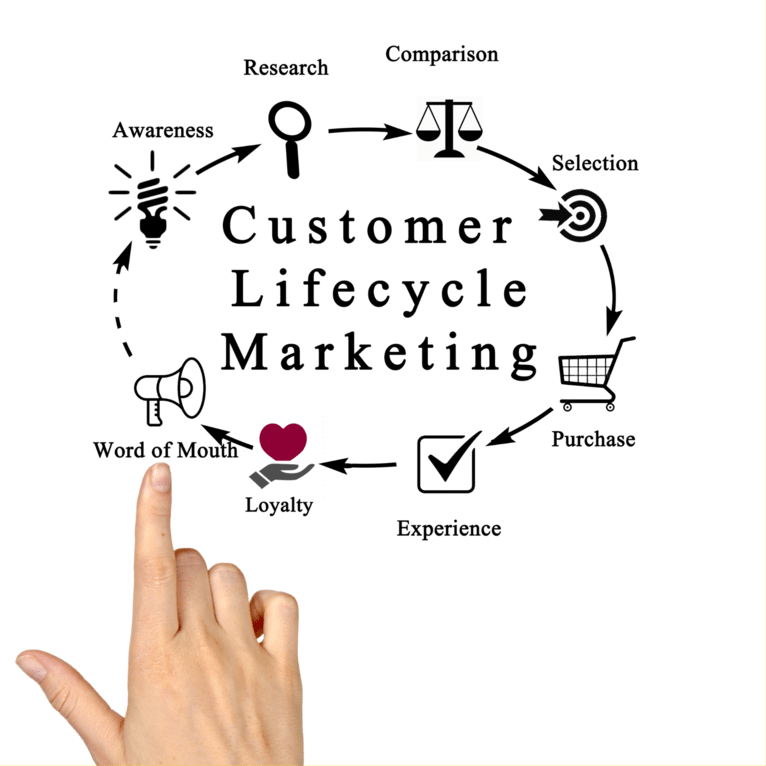Customer Lifecycle
The customer lifecycle represents the process of clients who become aware of a service or product, make purchases from a specific brand, and finally, become loyal customers.
Contents
- 1 Why it’s essential to understand the customer lifecycle?
- 2 Which are the five stages of the customer lifecycle?
- 3 Reach or awareness
- 4 Consideration
- 5 Acquisition / Conversion
- 6 Retention
- 7 Loyalty
- 8 The five main customer lifecycle management metrics
- 9 The key customer lifecycle management metrics
- 10 What is B2B customer lifecycle?
- 11 References
Why it’s essential to understand the customer lifecycle?
You may wonder which of the customer lifecycle stage is the most important. Understanding customer lifecycle is extremely helpful when planning and executing successful marketing. But for brands, it’s crucial to focus on each stage of the lifecycle and also improve communication with customers of each of those five stages. By understanding the customer lifecycle, brands understand the customers.
Which are the five stages of the customer lifecycle?
The five stages of the customer lifecycle
The customer lifecycle is made up of five stages:
- Reach or Awareness
- Acquisition / Consideration
- Conversion
- Retention
- Loyalty

Reach or awareness
Represent the first stage of the customer lifecycle. At this moment, customers become aware of a product or service through social media, television, the Internet, advertising, word of mouth, and other means. Most of the time, this means the brand has reached the target audience/ potential customers.
What do companies need to know regarding this stage? First, this is the stage businesses need to establish clear value propositions and also differentiate themselves from their competition. As stated before, awareness is accomplished through content marketing, targeted advertising, social listening, and other marketing strategies specific to social commerce meant to generate interest and raise awareness.
Consideration
Clients consider a product or service during this stage and start actively researching and evaluating their options. In this part, brands can give all the details about their products and services, such as benefits, features, and pricing. Brands must provide access to all this information on social media, the website, and other relevant channels.
Acquisition / Conversion
Once customers compare products and decide to buy, they move to the acquisition stage. In the purchase stage, brands have to make the whole process of buying as easy as they can. This includes offering clear indications for online purchases, customer service (mail, live chat), and providing several payment options.
Learn more about conversion by always calculating your conversion rate. A good conversion rate is around 2-5%.
Retention
After clients purchase your products, the focus must shift to customer retention. Finally, after clients purchase your products, the focus must go to retention. The retention stage is when brands must deliver on what they promised to be sure customers are satisfied with their purchases. From this point on, brands have a customer base that they need to keep loyal.

Retention includes excellent customer support, addressing concerns and questions in a timely manner, as well as ongoing support to help establish long-term relationships with customers and target audiences.
Keep in mind that good customer experiences mean satisfied clients are willing to come back and buy and even buy more the next time.
Loyalty
The last stage of the customer journey is loyalty and advocacy. Satisfied customers will become brand advocates for your brand by sharing your content online and recommending your products to others.
Word of mouth is a powerful marketing strategy for online marketing too. Advocacy is the ultimate form of marketing, as it relies on positive recommendations, leading to increased customer loyalty (existent, new and potential customers) and brand awareness. Brand loyalty is also related to how your customers view your brand and your values and actions. It is also a great way to retain customer loyalty and increase your sales/repurchases.
How can businesses improve advocacy?
Brands can encourage loyalty and advocacy through high-quality products and services, asking for feedback, and reviews, managing customer support properly, etc.
The five main customer lifecycle management metrics
The most successful companies know how vital customer lifecycle management is. For this reason, they consistently measure customer satisfaction for potential, new, and existing customers. Besides this, they measure the customer experience at different stages.
The key customer lifecycle management metrics
- Customer acquisition cost
- Net retention rate
- Customer retention rate
- Customer churn rate
- Customer Satisfaction Score (CSAT)
- Customer Lifetime Value (CLV)
What is B2B customer lifecycle?
B2B customer lifecycle refers to establishing long-term brand-customer relationships. When brands focus on B2B customer lifecycle, it is necessary to retarget customers as a part of retention strategies. More precisely, this means reapproaching current clients and placing them into the funnel via subscription-based campaigns, upselling, and cross-selling.
References
Psychology Tools, Assertive Communication, https://www.psychologytools.com/resource/assertive-communication/